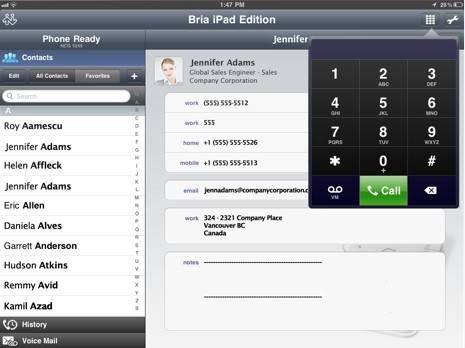
if you’ve been looking around for a solid VoIP/SIP client for the iPad or iPhone, consider CounterPath’s Bria.
For all the excitement around VoIP on the iPhone and iPod touch (including high profile apps like Skype, Vonage TalkFree for Facebook and Line2), relatively few developers have gone after the corporate side of the voice mix. With so many large enterprises using Asterisk-based PBX replacements for VoIP telephony, a solid SIP client for iPhone and iPad seems like a natural winner.
Bringing the advantage of its long pedigree in desktop VoIP clients, CounterPath now delivers some of that savvy to iOS with Bria. on the Mac, Bria is the successor to the capable EyeBeam and free X-lite softphones; now shipping on both the iPhone (US$7.99) and launched this week for the iPad ($14.99), it provides some of the key features needed in a mobile voice solution. Bria works out of the box with major IP-telephony service providers (ITSPs), but keep in mind it does not include service with the app; you need to be using a hosted service or your company’s IP telephony infrastructure for Bria to work.
the three most important considerations for any softphone app are call quality; call quality; and, of course, call quality. I was able to make and receive calls on several WiFi networks using Bria and a Fonality PBXtra server (built off the Trixbox Asterisk platform). while I heard a bit of near-side echo and low-bandwidth choppiness during some calls, most of the time the audio was as good or better than it would be on a conventional iPhone call, and less likely to drop. the people I called reported my voice quality as ‘awesome’ and ‘really spectacular,’ so it seems the artifacts I heard from time to time were on my side only.
It’s easy to set up Bria; the app takes the same credentials and server info you use for your desktop VoIP/SIP softphone. once you enter your server name and authorization, you can begin making and receiving calls. Bria is optimized for WiFi use, but it will work over 3G if you enable that option in preferences; however, you’re at risk of chewing up your wireless data allocation if you make a lot of calls that way, and quality will suffer a bit. on the flip side, you are not using any voice minutes, and for calls to colleagues on your internal phone system you will appear to be calling from your office extension — a great trick when you’re actually enjoying a piña colada by the pool.
the iPad edition of Bria works perfectly with multitasking, allowing you to switch apps and continue a call in the background. both standard wired headphone/mic combos and Bluetooth headsets work great, but what’s really surprising is that the iPad works quite well as a speakerphone — plop it onto your conference table and away you go.
you can optimize your voice quality by selecting a preferred codec in the advanced app preferences; this is also where you turn on 3G calling, set backgrounding options, and adjust other items. For the best quality on 3G calls, Counterpath offers the G.729 premium codec as an in-app purchase — unfortunately, it’s $8.99, so it’s unlikely to appeal to most users unless you really need the improved low-bandwidth mojo.
Backgrounding may affect your battery life, since most SIP servers will require a UDP connection that isn’t directly supported by Apple’s notification scheme; some newer servers may work with TCP, which does save power and improve background rings. you can also set incoming calls to forward to your cell number for when Bria’s not running.
CounterPath’s market position provides a good perspective on the impact of iOS and the Mac in the enterprise market, since its products address business needs almost exclusively. When I spoke to senior VP of marketing and products Todd Carothers earlier this week, he acknowledged the accelerating interest from businesses big and small in Apple platforms: “We have seen a significant enough growth in Mac Bria sales since the launch of 3.0 to SME/Enterprise customers. What’s happening is Enterprises want multiple OS support with common UI elements.” Being able to offer a consistent user experience across PC and mobile platforms would seem to be particularly important for telephony applications, since business users are going to spend a lot of time making and taking calls.
Bria is definitely a business product at a business price, and it’s a bit frustrating that CounterPath didn’t choose to deliver it as a universal app instead of the split-SKU arrangement in place now. nevertheless, if your company is rocking an IP PBX and you want a premium VoIP experience, there’s no better choice right now.